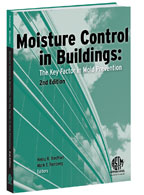
Moisture in Buildings
A Single ASTM Manual Provides Guidance for Moisture Control
The bottom line on moisture in buildings: control it - don't eliminate it - and the structure should last longer and need fewer repairs.
Guidance on such control can be found in a 600+ page manual, Moisture Control in Buildings: The Key Factor in Mold Prevention. The book, a new edition of a work first published in 2004, collects 28 chapters on the topic into one useful desktop reference.
Editors Heinz Trechsel and Mark Bomberg recruited chapter authors who are known for their expertise in various technical issues impacting moisture control. The duo also contributed their expertise to the book as chapter co-authors. Trechsel, who has been consulting on moisture problems in buildings for more than 25 years, has been an ASTM International member since 1961. Bomberg, a research professor at Syracuse University, has been involved in building physics for more than 25 years and has been a member of ASTM since 1976.
About the moisture in buildings, Trechsel says, "The science of moisture control in buildings is still evolving, and in some areas the experts differ on the interpretation of research results." Consequently, rather than singling out one approach and choosing authors accordingly, the editors preferred to have the book reflect the most current technology and the variety of approaches to addressing moisture-related issues in buildings.
The manual is intended to assist the building community in the design, construction, and maintenance of homes and offices. Three chapters have been added to this new edition.
- Details and Practice: Discusses difficult to manage wall and roof conditions with both conventional and innovative materials and products.
- Quality Management in Design and Construction: Recognizes building failures may be caused by a lack of proper coordination between drawings and specifications or lack of common understanding between design and construction, or one trade and another; also discusses the concept of quality management.
- Toward Development of Methods for Assessment of Moisture-Originated Damage: Considers the scientific basis for a future expansion of related ASTM standards.
Other chapters cover such topics as fundamentals and material hygrothermal characteristics, organisms and health effects, air infiltration, heat and cooling equipment, case studies and much more.
Bomberg notes that the new damage methods assessment chapter stresses a broader approach to durability. "The last chapter, written by authors from Switzerland, Belgium and the U.S., paves the road to including durability computations much in the same manner as we calculate structural safety of our buildings." The approach acknowledges that sustainability is critical, he adds, and deals with the scientific basis for an expansion of related ASTM standards.
Bomberg and Trechsel do express an important caution at the outset of the manual. In the introduction they write, "Although many chapters include specific recommendations, the editors caution the reader that each building is different, that conditions of building service and climate are different. Accordingly, no recommendations or details should be adopted without a careful analysis of the needs of the specific building."
 SN Home
SN Home Archive
Archive Advertisers
Advertisers Masthead
Masthead RateCard
RateCard Subscribe
Subscribe Email Editor
Email Editor